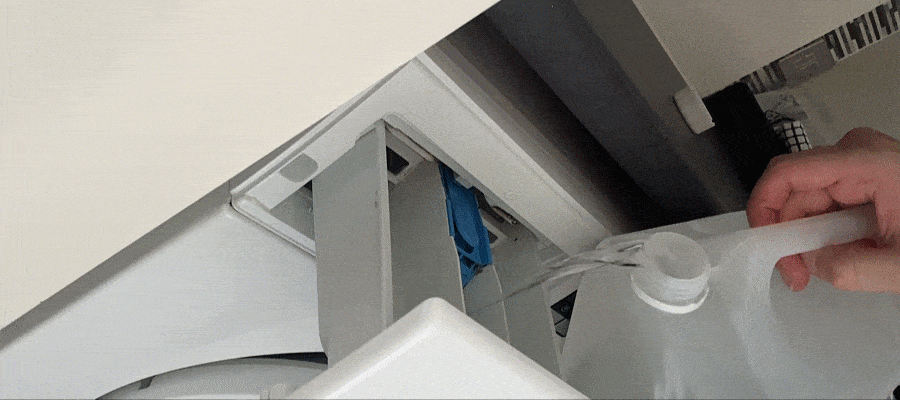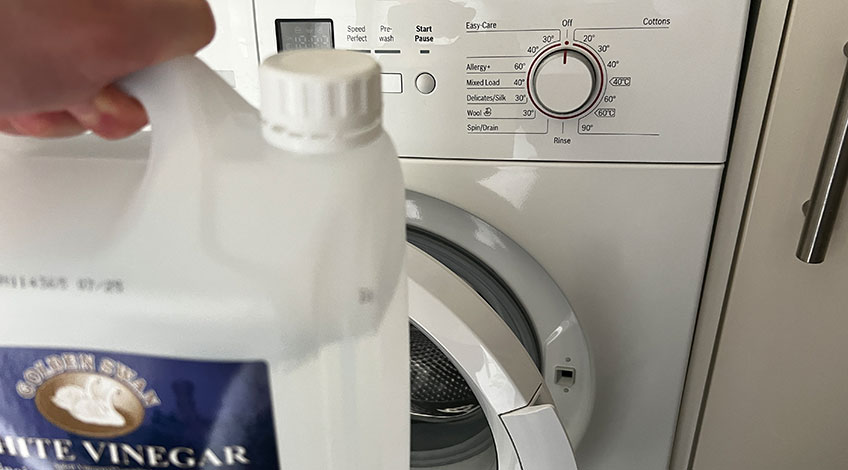
Easy Way To Clean A Washing Machine Drawer Using Vinegar
The detergent dispenser drawer on a washing machine needs to be cleaned regularly to prevent it becoming a breeding ground for germs, bacteria as well as mould and mildew. This can lead to foul smells coming from the dispenser drawer which can transfer onto your laundry.
There are numerous ways to clean the washing machine’s drawer and in this article I’m going to focus on using distilled white vinegar as a cleaning agent. Keep reading to find out exactly how to remove all of that unwanted soap scum, limescale, bacteria and mould and mildew from the dispenser drawer on your washing machine.
Why Use White Vinegar To Clean The Dispenser Drawer?

There are several reasons why I recommend using distilled white vinegar to clean the washing machine. Which include;
- It’s Effective
White vinegar will give you better cleaning results than using bleach, especially inside the detergent dispenser of a washing machine. Bleach will kill any bacteria or mould present on the surface at the time of use, whereas vinegar will penetrate deep into the problem and will prevent bacteria and mould from forming for longer. White vinegar is also great for removing limescale which can also form in the dispenser drawer. - It’s Inexpensive
Compared to commercial washing machine cleaners, distilled white vinegar is an incredibly cheap cleaning option. - It’s Gentler Than Bleach
Bleach and other commercial washing machine cleaners are all made from harsh chemicals that have the potential to cause damage to the washer if used incorrectly. White vinegar on the other hand, is a natural, gentle product that can effectively clean the dispenser drawer without the need for harsh chemicals.
How To Clean The Dispenser Drawer On A Washing Machine Using White Vinegar

Removing dried detergent, soap scum, mould, mildew, limescale and bacteria & germs from the detergent dispenser on your washing machine is a simple task. All you need is white vinegar and some elbow grease.
You will need;
- Distilled White Vinegar (brown vinegar stains which is why you need white vinegar)
- Spray Bottle
- Hot Water
- Soft Bristled Brush (like an old toothbrush or nail brush)
- Bucket
- Clean Cloth
Method
- Remove The Dispenser Drawer
The first thing to do is remove the detergent dispenser drawer from the washing machine. All dispenser drawers are removable on front loader washing machines (consult your user manual for model specific instructions). Take care to not damage the drawer (treat it gently). - Soak The Drawer
FIll the bucket with hot water and white vinegar in equal measure (50/50 mix). Place the dispenser in the bucket and allow it to soak for around 30 minutes. This will help to weaken the grip of any mould, mildew or limescale deposits. Once the dispenser has soaked in the solution for a while, turn it around to ensure that the whole drawer gets a good soaking. Then scrub the drawer thoroughly using a soft bristled brush. - Clean The Dispenser Drawer Housing
Whilst the drawer is soaking, you can tackle the drawer housing. Spray all of the inside with white vinegar from the spray bottle, and allow it to soak in. After 10 to 20 minutes (depending on the amount of detergent, mould, etc) scrub inside the housing using a soft bristled brush. You might have to repeat this process on any stubborn build ups. - Rinse & Dry The Dispenser
Once the drawer is completely clean and detergent & mould free, rinse with clean water and allow to air dry. Clean the housing using a clean cloth soaked in fresh water. Allow the housing to air dry as well. Once the drawer and housing are both dry, you can replace the drawer into the housing.
For more detailed information on how to clean the rest of your washing machine, follow this link.
How To Prevent The Dispenser Drawer From Detergent & Mould Build Up In The Future

Once you have invested all that time and energy removing the detergent build up and mould growth from the dispenser drawer and housing. There are a few preventative measures you can take to prevent it from happening again. These include;
Allowing The Washer To Breathe
The best way to prevent a build up of mould and mildew is to leave the dispenser drawer and washing machine door open when not in use. This allows fresh air to flow through the machine which ensures the surfaces are dried out between uses.
Mould and mildew thrive in damp environments, by drying the interior of the machine between uses, you will prevent the spores from growing.
Give The Washer A Wash
To keep your washing machine clean, you should run a hot 90o C service wash every month. This can be done using a commercial washing machine cleaner and following the advice on the packaging.
Or by adding 1 to 2 cups of distilled white vinegar to the dispenser drawer.
Rinse The Detergent Drawer
Once a week or at the very least, once a fortnight, you should remove the dispenser drawer and run it under a fast flowing tap. This will remove any detergent residue and prevent it from building up.
Be sure to allow the drawer to air dry before replacing it in the housing and don’t forget to leave the drawer and washer door open in between uses.
SEE ALSO: Washing Machine Drawer Compartments Explained (with drawer symbols)
Frequently Asked Questions
To remove hard limescale from the drawer on a washing machine, all you need to do is soak the drawer in a 50/50 solution of white vinegar and hot water. Allow the drawer to soak for 15 to 30 minutes then scrub using a soft bristled brush (like a toothbrush). Once all of the limescale has been removed, run a hot service wash using white vinegar once a month to prevent the limescale from building up again.
To remove mould from the washing machine’s detergent drawer, you need to remove the drawer and soak it in a 50/50 solution of white vinegar and hot water for 15 to 30 minutes. Then scrub the drawer using a soft bristled brush (like a toothbrush or nail brush). Running a hot service wash every month using 1 to 2 cups of white vinegar will help to prevent the mould from returning. You should also leave the dispenser drawer and washing machine door open to allow it to dry between uses.
White vinegar is better at removing mould and limescale from the detergent dispenser drawer because it is gentler, more effective and cheaper to buy. The acidic nature of the vinegar will dissolve the limescale build up whereas bleach isn’t as effective. Plus the vinegar will penetrate deeper to remove more of the mould spores.




